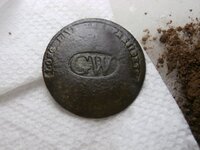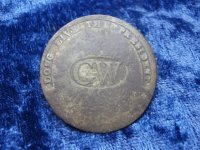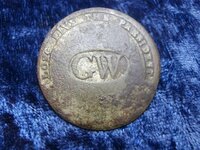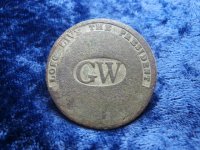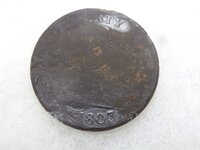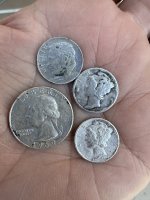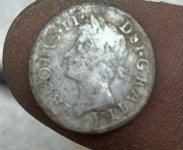Silver Tree Chaser
Bronze Member
BULLDOZED CELLAR HOLE = GEORGE WASHINGTON INAUGRURAL BUTTON & 11 COPPERS - NJ, FUGIO,
I’ve been detecting on & off for the past 30 years, but I’ve been going at it steadily with a concentration on colonial-period sites for the past 10 years, recovering many good finds. The last three years have been incredibly productive for me likely due to a number of factors; I’ve been very fortunate, and I’m thankful for that. I don’t know how long I can keep riding this wave, but for now I’ll just go with it and always hope for the best.
One elusive object on my most-wanted list for a long, long time was a George Washington Inaugural button, but not anymore!
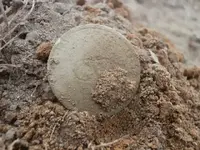
I recovered this stunning George Washington Inaugural button this past Thursday at a late 17th century cellar hole, and it was worth the wait. The harder the climb, the greater the view!
Here’s a wider view with the button (bottom and center) and my XP Deus. While the housing unit on the XP Deus in incredibly small (like cell phone small), it’s not a matter of scale that explains the apparent size of the GWI button. These GWI buttons are huge!
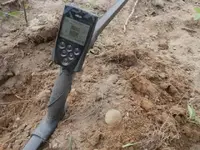
Here’s a review of events leading up the recovery of the GWI button. I have some pictures of the button after some careful conservation efforts near the end of my post. I hope you all like the end result.
I had searched this cellar hole several times over the past year and had little to show for all my efforts – a few coppers and little else. The cellar hole is in a wooded area tucked behind a modern building. My research indicated that the dwelling dated back to the late 17th century, and it appeared that no one had ever been there to search prior to my time on the site – detectorists and bottle diggers alike. It seems that searching in the woods is most definitely not my strong suit, as the site should have been much more productive. Anyway, planted crops throughout my area and dry weather prompted a return visit. I had brought a small arsenal of equipment – detector, digging tools, and a sifter, all of which would not be needed. Upon my arrival, I discovered that the entire area had been recently excavated with heavy equipment (possibly for a parking lot – ahhhhh!). I went to look for the cellar hole at the edge of the wooded area for a reference point. It was totally gone. I stood there only for a moment or two regretting the loss of the cellar hole while gazing out at a huge area of bare soil intermixed with broken brick, ceramics, and clay pipe stems. Then I thought to myself, “What are you waiting for stupid?”
The cellar hole is in a wooded area tucked behind a modern building. My research indicated that the dwelling dated back to the late 17th century, and it appeared that no one had ever been there to search prior to my time on the site – detectorists and bottle diggers alike. It seems that searching in the woods is most definitely not my strong suit, as the site should have been much more productive. Anyway, planted crops throughout my area and dry weather prompted a return visit. I had brought a small arsenal of equipment – detector, digging tools, and a sifter, all of which would not be needed. Upon my arrival, I discovered that the entire area had been recently excavated with heavy equipment (possibly for a parking lot – ahhhhh!). I went to look for the cellar hole at the edge of the wooded area for a reference point. It was totally gone. I stood there only for a moment or two regretting the loss of the cellar hole while gazing out at a huge area of bare soil intermixed with broken brick, ceramics, and clay pipe stems. Then I thought to myself, “What are you waiting for stupid?”  I grabbed my detector in the car and ran back onto the site like holiday shoppers storming the doors of Walmart at the start of Black Friday! The hunting went a bit slowly at first, but I soon had a flat button, followed by my first copper in a half-hour or so. When I soon after recovered my second copper, I knew that I was onto something good.
I grabbed my detector in the car and ran back onto the site like holiday shoppers storming the doors of Walmart at the start of Black Friday! The hunting went a bit slowly at first, but I soon had a flat button, followed by my first copper in a half-hour or so. When I soon after recovered my second copper, I knew that I was onto something good.
The site proved to be very productive, and I took full advantage of the situation, so please understand that this is a compilation post. All the searching and aftercare of finds, along with responsibilities at work and home, resulted in little time for posting on T-Net, sleep (what’s sleep?), or doing anything at a slow, leisurely pace. I recovered a total of six coppers and other assorted finds on my first trip over the course of two hours. I don’t pull six coppers up on a single outing very often; moreover, six early coins is my best total ever, which I’ve done a few times, but never in the space of a mere two hour outing. Needless to say, I was motivated. I juggled my schedule and got back to the site the very next day – thanks in part to my understanding wife who understood my need to strike while the iron was hot. I hit the site again for another solid six hours and pulled another four coppers and an assortment of other interesting finds. Photos of the better finds from the first two trips are as follows:
A 1786 (Maris 14-J) New Jersey Copper - The reverse side was more corroded, but at least I was able to fully identify its variety. The 1786 Maris 14 obverse only has a single reverse combination.
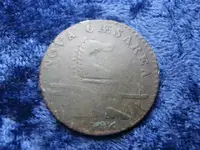
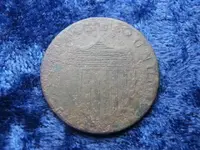
Curiously, this Fugio copper has been intentionally scratched with markings. I wonder if it was done to convey some type of message?
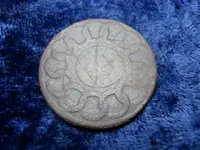
Here's a wonderful 1803 Draped Bust - Fractional Error Cent, 1/100 over 1/000, Variety S-249. Removing the stubborn buildup of dirt on the obverse side was a challenge, but the end result was good. The reverse side of the coin is incredibly well-preserved.
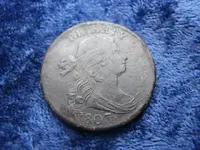
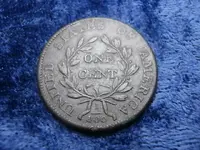
Here's a close-up view of the fractional 1/100 over 1/000
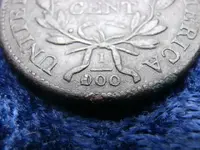
This King George II halfpence is in good overall condition, but the date is a big weak (175?).
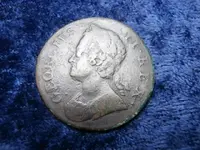
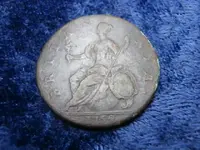
Here's an 1828 Large Cent
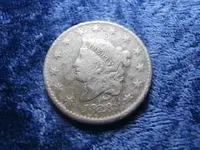
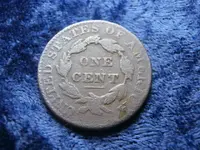
Here are the remaining coppers from the site.
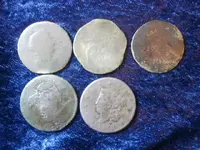
I haven't been able to determine anything specific about this small, delicate brass ring with a heart inscription on the bezel. I figured it for a trade ring, but those are of one-piece construction, while the bezel on this ring is brazed onto the band. I still think that it's quite old, but how old? 19th century? 18th Century? The other ring is gold over silver, a technique that does date back to the 19th century. It has no hallmarks.
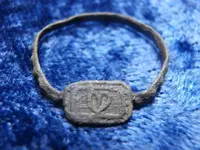
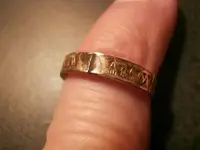
The site offered a selection of finds ranging from late 17th century to late 19th Century.
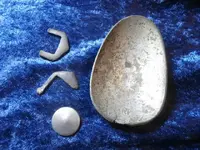
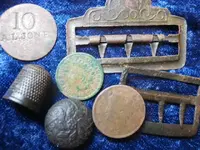
This seal spoon bowl from the late 17th century to early 18th century (probably a trifid-handle specimen) has a makers' mark - RP. If anyone has information on this maker's mark, I would very much appreciate a post on this thread.
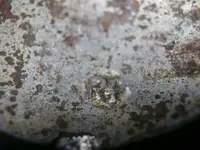
No complete buckles have been found, but I came across a number of fragments. A clear majority of the recovered buttons had missing or squashed shanks. Is the GWI button part of this majority? Keep reading to find out! Note the big, decorative button that had its center torn out with the shank.
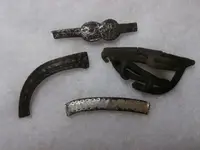
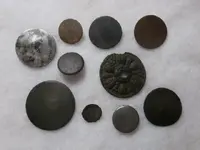
Here's some of the other utensils that I found on the site. The little pewter spoon is complete but very deteriorated.
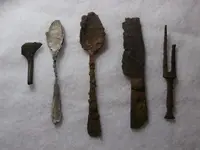
As a matter of course, I also dug the customary bucket of crap. I made sure to include this image for a little "truth in advertising." Anyone new to the detecting who might check this thread should know what they're in for when it comes to really hammering a site. It's not all GWI buttons and old coppers!
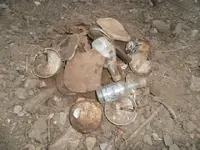
After two visits, I was up by 10 early coins – colonial and early US Large Cents. They were mostly recovered somewhat of a distance from the cellar hole and closer to the roadway. I still had a good deal of ground to cover right along the roadway. Thoughts of further finds yet discovered motivated me to push for a third trip to the site, and yes – third time’s a charm!
I got back to site five days later and the better finds seemed to be coming ever slower. I had found only a single flat button while making runs up and down the site immediately along the road, when I hit on a small worn silver coin about 1 & ½ hours into the hunt. It was a Spanish half-reale with a barely legible date of 1790. I later found out that it had been utilized as a button, as it a trace amount of applied silver for an apparent shank.
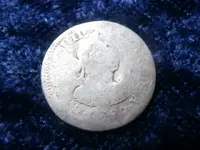
As a standard practice, I follow-up on significant finds by sweeping around the initial hole, and upon making my first full circle around the half-reale, I hit on a loud, strong signal. A scoop of my shovel did not produce the target, but it remained loud and clear at the center of the hole. I reached for a handful of loose dirt and fished out what appeared to be a huge coin. I noticed it was very thin. It was a button. I knew that GWI buttons are enormous in size, and what I just recovered certainly seemed to meet my expectations for the proper size of a big GWI button. I took a quick, reflex-like gaze at the button’s design and my eyes focused on exactly what I was hoping – one of the GWI button designs.
 Though the initials were just slightly obscured under a layer of dirt, I could immediately recognize the letters – GW set in an oval at the button’s center, and that was that! The button appeared to be in an excellent state of preservation, which thankfully allowed for an immediate, no doubt about it identification. I continued to examine the find to get past the disbelief of what I recovered. I found a completely intact, ramrod-straight shank protruding out the back seemingly in defiance of the bulldozers that had torn up the area only several weeks ago.
Though the initials were just slightly obscured under a layer of dirt, I could immediately recognize the letters – GW set in an oval at the button’s center, and that was that! The button appeared to be in an excellent state of preservation, which thankfully allowed for an immediate, no doubt about it identification. I continued to examine the find to get past the disbelief of what I recovered. I found a completely intact, ramrod-straight shank protruding out the back seemingly in defiance of the bulldozers that had torn up the area only several weeks ago.
I had searched for a GWI button for years, and then it happens as easy as 1, 2, & 3. – locate a signal, recover the target, and identify the find. Strangely, it also seems to happen in slow-motion; at least that’s been my experience. I sat in the dirt for a few minutes taking in the entire experience, yet I felt almost a nervous energy. But more than anything, it was fantastic! I took some pictures and shot some video. To be honest, I have mixed feelings about putting the video online, although I very much enjoy sharing the story and all the pictures on T-Net.
I continued to dig for few more hours and recovered copper #11, a 1785 Nova Constellatio along with other assorted finds.
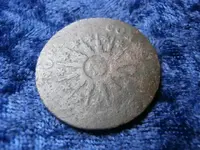
I walked off the site in near darkness and went home a bit tired but very happy. The tiredness faded as soon as I got home for a closer look at my prized GWI button find. After a light brushing, I had some concerns about its appearance , but I began treating it in the same fashion that I treat all my coppers and any copper-alloy finds. Over a five-day period, the appearance of the button improved considerably. I became quite concerned with the button’s condition at one point, as I began to notice a yellowish-brown hue on various areas of the design. I soon realized it was gold gilt still visible from when the button was manufactured back in 1789!
, but I began treating it in the same fashion that I treat all my coppers and any copper-alloy finds. Over a five-day period, the appearance of the button improved considerably. I became quite concerned with the button’s condition at one point, as I began to notice a yellowish-brown hue on various areas of the design. I soon realized it was gold gilt still visible from when the button was manufactured back in 1789!  How cool is that? Anyway, here’s the before and after photos and some other images as well.
How cool is that? Anyway, here’s the before and after photos and some other images as well.
This image shows the button on the evening that it was recovered. Lots of apparent potential, but also a lot of dirt that required careful removal.
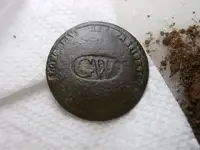
Here's the end result after four days of careful treatment.


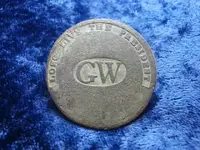
Here's an image of the button's shank that remained wonderfully intact.

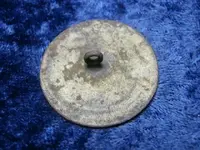
Here's my favorite group shot of my GWI button and the better coppers recovered from the site.


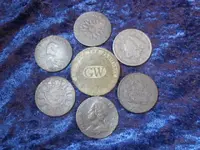
I believe that the button’s overall condition and appearance is quite good for a dug specimen. I just love the contrast between the “GW – LONG LIVE THE PRESIDENT” legend with its brown patina over the gold gilt background. After reading up on GWI buttons, I’ve identified it as an Albert’s W1 11-A (narrow spacing) – “GW – LONG LIVE THE PRESIDENT.” It’s a big 34 mm in size. It dates to George Washington’s first inauguration back in 1789.
Sorry for going on for so long with all the details, but it seems appropriate for big finds. I did the hit the site again on a fourth trip, but the recovery of finds slowed down considerably. But how about some heavy rain or some different settings on my XP Deus to shake things up? I don’t think it over yet – not by a long shot. I have one remaining area of high ground that I have not yet searched thoroughly. There’s a heavy layer of iron to contend with in this specific area. Anybody have recommendations for the Deus when working in thick iron? Finally, I’ve got one spot staked out that might be an early trash pit, as I began to dig lots and lots of oyster shells while recovering a target. That’s a hole I need to open up soon for further investigation. Bill D. – I’ll be sending you a PM to request advice on digging that hole.
Well, I’ve got to finally wrap this up. I'm busy preparing these finds for a display at the New England Treasure Show in Taunton, MA this coming Saturday. I’m all fired up for displaying these recent finds at the day-long event, which is being sponsored by a local metal detecting club. If anyone in the New England area is interested in attending, and it’s o.k. with the Admin., I’ll provide a link on this thread. Just let me know if you would like to attend.
for displaying these recent finds at the day-long event, which is being sponsored by a local metal detecting club. If anyone in the New England area is interested in attending, and it’s o.k. with the Admin., I’ll provide a link on this thread. Just let me know if you would like to attend.
Again, sorry for the long post. I hope the story and photos are enjoyed by all. Thank you.
Good Hunting!
I’ve been detecting on & off for the past 30 years, but I’ve been going at it steadily with a concentration on colonial-period sites for the past 10 years, recovering many good finds. The last three years have been incredibly productive for me likely due to a number of factors; I’ve been very fortunate, and I’m thankful for that. I don’t know how long I can keep riding this wave, but for now I’ll just go with it and always hope for the best.
One elusive object on my most-wanted list for a long, long time was a George Washington Inaugural button, but not anymore!


I recovered this stunning George Washington Inaugural button this past Thursday at a late 17th century cellar hole, and it was worth the wait. The harder the climb, the greater the view!
Here’s a wider view with the button (bottom and center) and my XP Deus. While the housing unit on the XP Deus in incredibly small (like cell phone small), it’s not a matter of scale that explains the apparent size of the GWI button. These GWI buttons are huge!

Here’s a review of events leading up the recovery of the GWI button. I have some pictures of the button after some careful conservation efforts near the end of my post. I hope you all like the end result.
I had searched this cellar hole several times over the past year and had little to show for all my efforts – a few coppers and little else.
 The cellar hole is in a wooded area tucked behind a modern building. My research indicated that the dwelling dated back to the late 17th century, and it appeared that no one had ever been there to search prior to my time on the site – detectorists and bottle diggers alike. It seems that searching in the woods is most definitely not my strong suit, as the site should have been much more productive. Anyway, planted crops throughout my area and dry weather prompted a return visit. I had brought a small arsenal of equipment – detector, digging tools, and a sifter, all of which would not be needed. Upon my arrival, I discovered that the entire area had been recently excavated with heavy equipment (possibly for a parking lot – ahhhhh!). I went to look for the cellar hole at the edge of the wooded area for a reference point. It was totally gone. I stood there only for a moment or two regretting the loss of the cellar hole while gazing out at a huge area of bare soil intermixed with broken brick, ceramics, and clay pipe stems. Then I thought to myself, “What are you waiting for stupid?”
The cellar hole is in a wooded area tucked behind a modern building. My research indicated that the dwelling dated back to the late 17th century, and it appeared that no one had ever been there to search prior to my time on the site – detectorists and bottle diggers alike. It seems that searching in the woods is most definitely not my strong suit, as the site should have been much more productive. Anyway, planted crops throughout my area and dry weather prompted a return visit. I had brought a small arsenal of equipment – detector, digging tools, and a sifter, all of which would not be needed. Upon my arrival, I discovered that the entire area had been recently excavated with heavy equipment (possibly for a parking lot – ahhhhh!). I went to look for the cellar hole at the edge of the wooded area for a reference point. It was totally gone. I stood there only for a moment or two regretting the loss of the cellar hole while gazing out at a huge area of bare soil intermixed with broken brick, ceramics, and clay pipe stems. Then I thought to myself, “What are you waiting for stupid?”  I grabbed my detector in the car and ran back onto the site like holiday shoppers storming the doors of Walmart at the start of Black Friday! The hunting went a bit slowly at first, but I soon had a flat button, followed by my first copper in a half-hour or so. When I soon after recovered my second copper, I knew that I was onto something good.
I grabbed my detector in the car and ran back onto the site like holiday shoppers storming the doors of Walmart at the start of Black Friday! The hunting went a bit slowly at first, but I soon had a flat button, followed by my first copper in a half-hour or so. When I soon after recovered my second copper, I knew that I was onto something good. The site proved to be very productive, and I took full advantage of the situation, so please understand that this is a compilation post. All the searching and aftercare of finds, along with responsibilities at work and home, resulted in little time for posting on T-Net, sleep (what’s sleep?), or doing anything at a slow, leisurely pace. I recovered a total of six coppers and other assorted finds on my first trip over the course of two hours. I don’t pull six coppers up on a single outing very often; moreover, six early coins is my best total ever, which I’ve done a few times, but never in the space of a mere two hour outing. Needless to say, I was motivated. I juggled my schedule and got back to the site the very next day – thanks in part to my understanding wife who understood my need to strike while the iron was hot. I hit the site again for another solid six hours and pulled another four coppers and an assortment of other interesting finds. Photos of the better finds from the first two trips are as follows:
A 1786 (Maris 14-J) New Jersey Copper - The reverse side was more corroded, but at least I was able to fully identify its variety. The 1786 Maris 14 obverse only has a single reverse combination.


Curiously, this Fugio copper has been intentionally scratched with markings. I wonder if it was done to convey some type of message?

Here's a wonderful 1803 Draped Bust - Fractional Error Cent, 1/100 over 1/000, Variety S-249. Removing the stubborn buildup of dirt on the obverse side was a challenge, but the end result was good. The reverse side of the coin is incredibly well-preserved.


Here's a close-up view of the fractional 1/100 over 1/000

This King George II halfpence is in good overall condition, but the date is a big weak (175?).


Here's an 1828 Large Cent


Here are the remaining coppers from the site.

I haven't been able to determine anything specific about this small, delicate brass ring with a heart inscription on the bezel. I figured it for a trade ring, but those are of one-piece construction, while the bezel on this ring is brazed onto the band. I still think that it's quite old, but how old? 19th century? 18th Century? The other ring is gold over silver, a technique that does date back to the 19th century. It has no hallmarks.


The site offered a selection of finds ranging from late 17th century to late 19th Century.


This seal spoon bowl from the late 17th century to early 18th century (probably a trifid-handle specimen) has a makers' mark - RP. If anyone has information on this maker's mark, I would very much appreciate a post on this thread.

No complete buckles have been found, but I came across a number of fragments. A clear majority of the recovered buttons had missing or squashed shanks. Is the GWI button part of this majority? Keep reading to find out! Note the big, decorative button that had its center torn out with the shank.


Here's some of the other utensils that I found on the site. The little pewter spoon is complete but very deteriorated.

As a matter of course, I also dug the customary bucket of crap. I made sure to include this image for a little "truth in advertising." Anyone new to the detecting who might check this thread should know what they're in for when it comes to really hammering a site. It's not all GWI buttons and old coppers!

After two visits, I was up by 10 early coins – colonial and early US Large Cents. They were mostly recovered somewhat of a distance from the cellar hole and closer to the roadway. I still had a good deal of ground to cover right along the roadway. Thoughts of further finds yet discovered motivated me to push for a third trip to the site, and yes – third time’s a charm!
I got back to site five days later and the better finds seemed to be coming ever slower. I had found only a single flat button while making runs up and down the site immediately along the road, when I hit on a small worn silver coin about 1 & ½ hours into the hunt. It was a Spanish half-reale with a barely legible date of 1790. I later found out that it had been utilized as a button, as it a trace amount of applied silver for an apparent shank.

As a standard practice, I follow-up on significant finds by sweeping around the initial hole, and upon making my first full circle around the half-reale, I hit on a loud, strong signal. A scoop of my shovel did not produce the target, but it remained loud and clear at the center of the hole. I reached for a handful of loose dirt and fished out what appeared to be a huge coin. I noticed it was very thin. It was a button. I knew that GWI buttons are enormous in size, and what I just recovered certainly seemed to meet my expectations for the proper size of a big GWI button. I took a quick, reflex-like gaze at the button’s design and my eyes focused on exactly what I was hoping – one of the GWI button designs.
I had searched for a GWI button for years, and then it happens as easy as 1, 2, & 3. – locate a signal, recover the target, and identify the find. Strangely, it also seems to happen in slow-motion; at least that’s been my experience. I sat in the dirt for a few minutes taking in the entire experience, yet I felt almost a nervous energy. But more than anything, it was fantastic! I took some pictures and shot some video. To be honest, I have mixed feelings about putting the video online, although I very much enjoy sharing the story and all the pictures on T-Net.
I continued to dig for few more hours and recovered copper #11, a 1785 Nova Constellatio along with other assorted finds.

I walked off the site in near darkness and went home a bit tired but very happy. The tiredness faded as soon as I got home for a closer look at my prized GWI button find. After a light brushing, I had some concerns about its appearance
 How cool is that? Anyway, here’s the before and after photos and some other images as well.
How cool is that? Anyway, here’s the before and after photos and some other images as well. This image shows the button on the evening that it was recovered. Lots of apparent potential, but also a lot of dirt that required careful removal.

Here's the end result after four days of careful treatment.


Here's an image of the button's shank that remained wonderfully intact.



Here's my favorite group shot of my GWI button and the better coppers recovered from the site.




I believe that the button’s overall condition and appearance is quite good for a dug specimen. I just love the contrast between the “GW – LONG LIVE THE PRESIDENT” legend with its brown patina over the gold gilt background. After reading up on GWI buttons, I’ve identified it as an Albert’s W1 11-A (narrow spacing) – “GW – LONG LIVE THE PRESIDENT.” It’s a big 34 mm in size. It dates to George Washington’s first inauguration back in 1789.
Sorry for going on for so long with all the details, but it seems appropriate for big finds. I did the hit the site again on a fourth trip, but the recovery of finds slowed down considerably. But how about some heavy rain or some different settings on my XP Deus to shake things up? I don’t think it over yet – not by a long shot. I have one remaining area of high ground that I have not yet searched thoroughly. There’s a heavy layer of iron to contend with in this specific area. Anybody have recommendations for the Deus when working in thick iron? Finally, I’ve got one spot staked out that might be an early trash pit, as I began to dig lots and lots of oyster shells while recovering a target. That’s a hole I need to open up soon for further investigation. Bill D. – I’ll be sending you a PM to request advice on digging that hole.
Well, I’ve got to finally wrap this up. I'm busy preparing these finds for a display at the New England Treasure Show in Taunton, MA this coming Saturday. I’m all fired up
 for displaying these recent finds at the day-long event, which is being sponsored by a local metal detecting club. If anyone in the New England area is interested in attending, and it’s o.k. with the Admin., I’ll provide a link on this thread. Just let me know if you would like to attend.
for displaying these recent finds at the day-long event, which is being sponsored by a local metal detecting club. If anyone in the New England area is interested in attending, and it’s o.k. with the Admin., I’ll provide a link on this thread. Just let me know if you would like to attend.Again, sorry for the long post. I hope the story and photos are enjoyed by all. Thank you.
Good Hunting!
Last edited:
Upvote
124



 That's a site you'll never forget but I'm sure you'll be back there many times unless of course they do turn it into a parking lot. Thanks for posting.
That's a site you'll never forget but I'm sure you'll be back there many times unless of course they do turn it into a parking lot. Thanks for posting.
